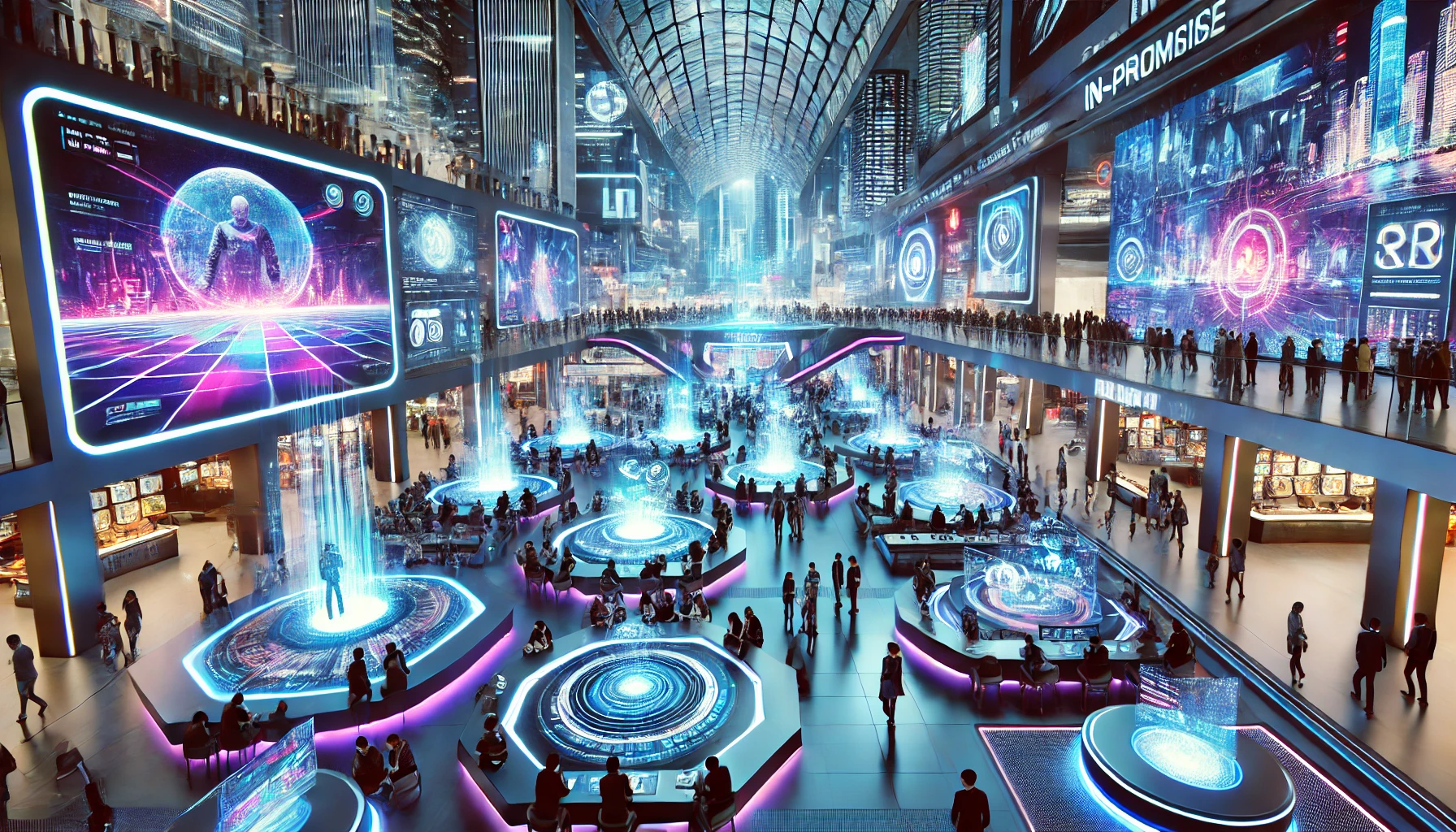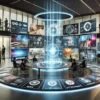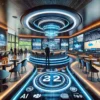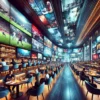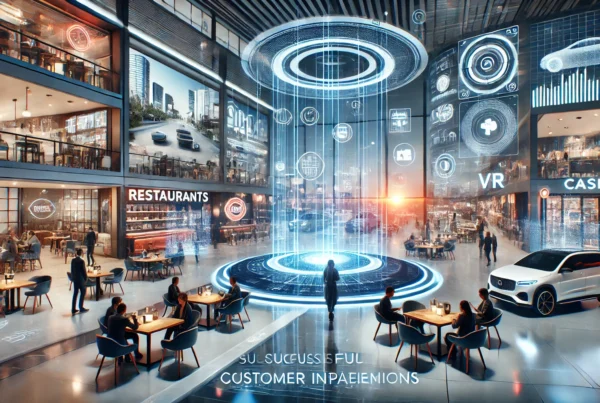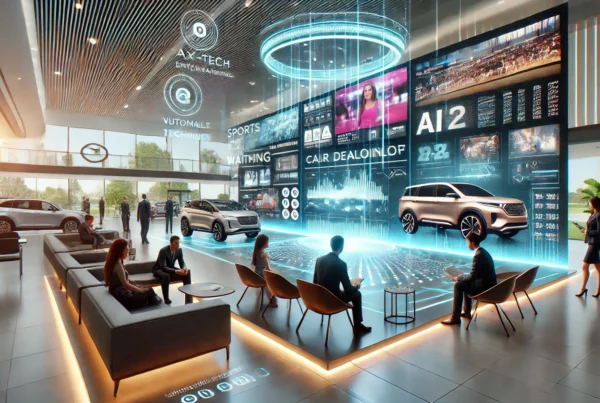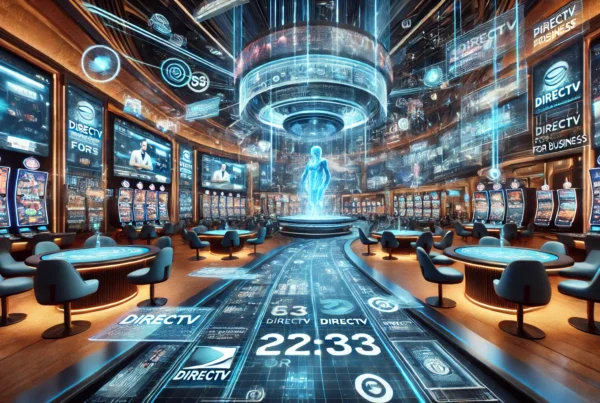Imagine walking into a bustling sports bar, where the atmosphere is electric, and the entertainment is nothing short of revolutionary. This is not a scene from a distant future but an emerging reality, thanks to the rapid advancements in in-premise entertainment technologies. From virtual reality (VR) experiences that transport patrons to new worlds to augmented reality (AR) overlays that bring live events to life, the future of in-premise entertainment is set to redefine customer experiences across various industries.
For business owners and decision-makers in the hospitality, gaming, auto, and private office sectors, understanding these trends is crucial. The integration of cutting-edge technologies not only attracts customers but also creates immersive and memorable experiences that drive repeat visits and customer loyalty. At Sports Direct, we are committed to helping businesses leverage these innovations to stay ahead of the competition and enhance their in-premise entertainment offerings.
In this blog post, we will explore the key trends and technologies shaping the future of in-premise entertainment. From the rise of VR and AR to interactive touchscreens and data-driven personalization, we will delve into how these advancements are transforming the way businesses engage with their customers. Additionally, we will examine real-world examples and case studies that highlight the impact of these technologies on customer satisfaction and business growth.
Join us as we embark on this journey to uncover the future of in-premise entertainment. Discover how these innovations can elevate your business and create unparalleled experiences for your customers. Stay tuned as we dive into the first trend: the transformative power of virtual reality in entertainment venues.
Emerging Technologies Transforming In-Premise Entertainment
The future of in-premise entertainment is being shaped by a wave of emerging technologies that are revolutionizing the way we experience leisure and social activities. Among these, virtual reality (VR) and augmented reality (AR) stand out as game-changers, offering immersive and interactive experiences that captivate audiences and open up new business opportunities.
For business owners in the hospitality, gaming, auto, and private office sectors, understanding and leveraging these technologies is crucial. They not only enhance customer engagement but also create memorable experiences that drive repeat visits and foster customer loyalty. Let’s delve into how VR and AR are transforming in-premise entertainment and explore their potential impacts.
Virtual Reality: Immersive Experiences Redefined
Virtual reality has made significant strides in recent years, becoming a cornerstone of modern in-premise entertainment. With devices like the Oculus Rift and HTC Vive, businesses can offer patrons experiences that transport them to entirely new worlds. Imagine a sports bar where customers can virtually attend a live game, feeling as if they are right in the stadium, or a casino offering VR poker games that mimic the thrill of a real-life casino floor.
Case studies highlight the success of VR in various settings. For example, a VR entertainment complex in Tokyo offers diverse experiences, from horror-themed adventures to serene underwater explorations, attracting a wide range of visitors. Similarly, businesses in the hospitality sector can create dedicated VR zones where customers can engage in multiplayer games, fostering social connections and increasing dwell times.
Augmented Reality: Enhancing the Real World
Augmented reality overlays digital information onto the physical world, creating a blended experience that enhances customer interaction with their environment. AR can transform static settings into dynamic, interactive spaces. For instance, AR apps can provide real-time stats and player bios during live sports events, enriching the viewing experience and offering new engagement opportunities.
In retail and hospitality settings, AR can turn a simple shopping trip or dining experience into an interactive journey. Products can showcase their features as customers pass by, and menus can come to life with visual representations of dishes. This not only captivates customers but also provides valuable information that can influence purchasing decisions.
Interactive Touchscreens and Kiosks: Engaging and Informative
Interactive touchscreens and kiosks are becoming increasingly prevalent in in-premise entertainment venues. These technologies offer a hands-on way for customers to engage with content, from digital menus and event calendars to interactive games and educational displays. For example, a sports bar might use touchscreens to allow patrons to customize their viewing experience, selecting channels or accessing real-time game statistics.
Moreover, interactive kiosks can streamline customer service, providing information and assistance without the need for staff intervention. This not only enhances the customer experience but also improves operational efficiency. Businesses can use these technologies to create a seamless and engaging environment that keeps customers coming back.
As we continue to explore the potential of emerging technologies in in-premise entertainment, it’s clear that VR, AR, and interactive systems are at the forefront of this transformation. By integrating these innovations, businesses can offer unique and captivating experiences that set them apart from the competition and drive sustained customer engagement.
Personalization and Customer Engagement
In the rapidly evolving landscape of in-premise entertainment, personalization has emerged as a cornerstone for enhancing customer engagement and loyalty. By leveraging advanced technologies, businesses can create tailored experiences that resonate deeply with their patrons, fostering a sense of connection and satisfaction.
From data-driven insights to customizable entertainment options, the future of in-premise entertainment hinges on the ability to offer personalized experiences. This section delves into the importance of personalization, the tools and strategies available, and real-world examples of successful implementations.
The Importance of Personalization in Customer Engagement
Personalization is no longer a luxury; it is a necessity in today’s competitive market. Customers expect experiences that cater to their individual preferences and needs. According to a study by Accenture, 91% of consumers are more likely to shop with brands that provide relevant offers and recommendations.
In the context of in-premise entertainment, personalization can take many forms. For instance, a sports bar might use customer data to recommend specific games or events based on past viewing habits. Similarly, a casino could offer personalized gaming experiences, tailoring the environment and game options to suit individual preferences.
Tools and Strategies for Offering Personalized Experiences
To achieve effective personalization, businesses can utilize a variety of tools and strategies:
- Data Analytics: By analyzing customer data, businesses can gain insights into preferences and behaviors, allowing them to tailor their offerings accordingly. Tools like CRM systems and data analytics platforms are invaluable in this regard.
- AI and Machine Learning: AI-powered systems can predict customer preferences and automate personalized recommendations. For example, AI can suggest menu items in a restaurant based on a customer’s previous orders.
- Interactive Technologies: Touchscreens and kiosks can offer personalized content, such as customized menus or interactive games. These technologies not only engage customers but also provide valuable data for further personalization.
Case Studies and Examples
Several businesses have successfully implemented personalization strategies to enhance customer engagement:
1. The Wynn Las Vegas: This luxury resort uses AI to personalize guest experiences. From room preferences to dining recommendations, the AI system ensures that each guest receives a tailored experience, resulting in higher satisfaction and repeat visits.
2. Starbucks: The coffee giant uses data analytics to personalize its rewards program. By analyzing purchase history, Starbucks offers customized rewards and promotions, which has significantly boosted customer loyalty.
3. Dave & Buster’s: This entertainment venue uses interactive kiosks to offer personalized gaming experiences. Customers can select games based on their preferences, and the system provides tailored recommendations for new games to try.
As these examples illustrate, personalization is a powerful tool for enhancing customer engagement and loyalty. By leveraging data and technology, businesses can create memorable and meaningful experiences that keep customers coming back.
Operational Efficiency with Smart Solutions
In the evolving landscape of in-premise entertainment, smart solutions are becoming indispensable for enhancing operational efficiency. These technologies not only elevate the customer experience but also streamline processes and reduce overheads for entertainment venues. Let’s delve into how these innovations are transforming operations and driving efficiency.
By integrating smart solutions, businesses can automate routine tasks, optimize resource management, and improve overall productivity. This shift is crucial for staying competitive in an industry where customer expectations are constantly rising.
Automated Inventory and Supply Chain Management
One of the significant benefits of smart solutions is the automation of inventory and supply chain management. Advanced systems can monitor stock levels in real-time, predict demand, and automate ordering processes. This ensures that businesses are always prepared to meet customer needs without overstocking or running into shortages.
For example, a sports bar can use smart inventory systems to track beverage consumption and automatically reorder supplies before they run out. This not only saves time but also reduces waste and improves cost efficiency.
Energy-Efficient Technologies
Implementing energy-efficient technologies is another way smart solutions enhance operational efficiency. From LED lighting to smart climate control systems, these innovations help reduce energy consumption and lower utility costs.
Consider a casino that uses smart thermostats and lighting systems to adjust settings based on occupancy and activity levels. This not only creates a comfortable environment for patrons but also significantly cuts down on energy expenses.
Security and Surveillance Enhancements
Modern security and surveillance technologies are essential for ensuring the safety of customers and staff while protecting business assets. Smart solutions like facial recognition, AI-powered surveillance, and advanced access control systems provide robust security measures.
For instance, a lounge can implement facial recognition technology to monitor entry points and identify potential threats in real-time. This proactive approach enhances security and fosters a safe and welcoming atmosphere for guests.
As we continue to explore the potential of smart solutions in in-premise entertainment, it’s clear that these technologies are pivotal in driving operational efficiency. By automating processes, optimizing resource use, and enhancing security, businesses can focus on delivering exceptional customer experiences while maintaining a competitive edge.
Embracing the Future of In-Premise Entertainment
The future of in-premise entertainment holds boundless potential as technology continues to evolve. By embracing emerging technologies, personalizing customer experiences, and enhancing operational efficiency, businesses can stay ahead of the curve and offer unparalleled entertainment experiences.
**Key Takeaways:**
- Virtual Reality (VR): VR offers immersive experiences that transport patrons to new worlds, enhancing customer engagement and satisfaction.
- Augmented Reality (AR): AR overlays digital information onto the physical world, creating interactive and dynamic environments.
- Interactive Touchscreens and Kiosks: These technologies provide hands-on engagement and streamline customer service.
- Personalization: Leveraging data and AI to tailor experiences to individual preferences fosters customer loyalty.
- Smart Solutions: Automating routine tasks and optimizing resource management improves operational efficiency.
As we look ahead, it is clear that businesses willing to invest in these advancements will set themselves apart. By integrating VR, AR, interactive touchscreens, and data-driven personalization, they can create memorable and engaging experiences that keep customers coming back.
**Call to Action:**
We invite you to explore more about these technologies and how they can transform your business. Visit Sports Direct for additional insights and resources on enhancing in-premise entertainment. Embrace the future and elevate your customer experiences today!
**Final Thought:**
How will you leverage these innovations to redefine your customer experience? Share your thoughts and join the conversation in the comments below.

